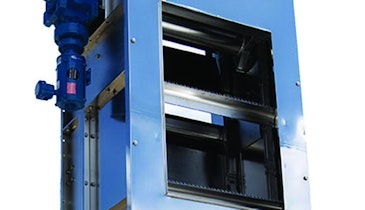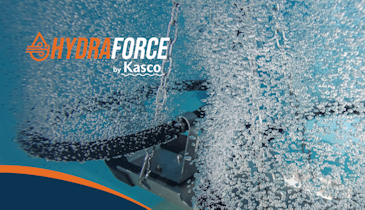Wastewater effluent is the final product of previous treatment processes, and effluent that meets certain quality standards can be discharged into bodies of water, such as streams, rivers or wetlands. Since the Clean Water Act in the 1970s, and similar regulations throughout the world, wastewater treatment processes — both municipal and industrial — must continuously meet increasingly strict requirements for the quality of the effluent stream. This is an ongoing challenge, as increasing populations and growing industries use more water and produce more wastewater, making it necessary to improve the efficiency of removing byproducts and pollutants to meet established environmental regulatory limits.
Both the volume of flow and the amount and type of contaminants can vary in the effluent stream of a wastewater treatment process. Wastewater is identified with different strengths, which is determined by the amount of contaminants in the stream. Wastewater from an industrial process typically contains a highly variable chemical composition and often has a high strength, so it requires a rapid method of measuring the organic composition.
Common methods of analyzing effluent
There are several commonly used measurement methods for identifying the amount of organic matter in wastewater, including biochemical oxygen demand, chemical oxygen demand and total organic carbon.
BOD testing is one of the most common methods. It involves introducing a small seed of bacteria to the effluent sample, and monitoring for a corresponding decrease in dissolved oxygen over a five-day period. This method has some drawbacks. First, many wastewater treatment processes, especially industrial wastewater plants, cannot wait five days for water-quality analysis when they need to make real-time decisions. Also, the presence of certain chemicals like solvents, chlorine or sanitizers in the effluent stream can prevent the growth and activity of the bacteria, resulting in low BOD test results. Because of this, the U.S. EPA Method 405.1 states, “There is no acceptable procedure for determining the accuracy of the BOD test.”
A COD test is a common alternative to BOD testing. COD uses chemical oxidation to measure chemically oxidizable contaminates in the effluent. It can be done in cycles of 30 minutes to two hours. COD is often used in conjunction with BOD testing.
Hach’s BioTector TOC analyzer oxidizes organic carbon to carbon dioxide for the TOC measurement. Organic carbon present in the sample is oxidized to carbon dioxide by a chemical process using hydroxyl radicals and catalyzed ozone. The carbon dioxide generated after the oxidation process is then measured by a non-dispersive infrared (NDIR) CO2 detector. Measuring total organic carbon is an excellent method to measure wastewater effluent. This method can identify some pollutants more accurately than BOD or COD tests, and can do so faster and in real time.
Why BioTector is better
Hach’s BioTector TOC analyzer uses a unique Two-Stage Advanced Oxidation technology to deliver highly reliable measurement and accurate data. Designed with self-cleaning technology in the reactor and internal tubing and powerful oxidation capabilities, the BioTector’s family of TOC analyzers offers a proven uptime of 99.86 percent. A BioTector analyzer can handle a wide variety of effluent water samples without impacting analysis or experiencing buildup inside the reactor or sample tubing. In fact, routine service is only required twice a year.
Industrial effluent can contain a variety of organic and inorganic substances depending on the type of industry. Pollutants can enter the process stream through product loss, cleaning of equipment, transition of processes, or from spent water used in a cooling process. An overload of organics in the effluent will indicate problems in the efficiency of the wastewater treatment process, and if the waste is not treated properly, the plant would not be able to discharge the water in compliance with environmental regulations. Hach’s BioTector TOC analyzer is the best option to measure the organics in the wastewater. Because it analyzes samples and provides online data, it is possible to make operational decisions based on accurate, real-time data. Also, the BioTector is designed to handle variable effluent streams with ease without an impairment of function.
Municipal wastewater effluent comes from residential and commercial sewage, and tends to be comprised of:
- Suspended solids
- Decaying organic waste
- Disease-causing pathogens and bacteria
- Nutrients, such as nitrogen and phosphorus
- Household chemicals
Effluent from municipal wastewater treatment plants tends to be less variable, and weaker in strength than industrial wastewater effluent. However, anomalies are not uncommon, and an unexpected surge in contaminants can cause problems for wastewater treatment plants using a five-day BOD test.
Hach’s BioTector TOC analyzer is an excellent supplement to effluent measurement, to ensure that water quality meets requirements in between the spot sampling of BOD testing. In the United States, TOC analysis can be used in lieu of BOD testing for oxygen-demanding substances. After a correlation between TOC and BOD is established, Hach’s BioTector TOC results can be used to determine BOD in the effluent stream quickly and reliably.
Benefits of a Hach BioTector
Hach’s BioTector TOC analyzer measures the carbon content of dissolved and undissolved organic matter present in a wastewater sample to help industrial and municipal wastewater treatment plants identify contamination or overloads, optimize and control the treatment process, and avoid environmental damage from toxic effluent being released.
The BioTector has a MCert certified 99.86 percent uptime, with only routine maintenance required every six months, and no calibration requirement between services. Its built-in, self-cleaning technology enables the BioTector analyzer to handle a wide variety of clean and dirty effluent waters. Plus, it is easy to operate.
Hach’s BioTector TOC analyzer:
- Ensures environmental compliance by identifying changes in the amount of organics in the effluent stream
- Delivers a fast return on investment by avoiding environmental fines, eliminating unplanned downtime and reducing ongoing maintenance requirements
- Operates with a low cost of ownership, with infrequent routine service carried out only twice a year
The sheer amount of wastewater treated by municipal and industrial wastewater treatment plants makes the regulation of treated wastewater an effort critical to the health and safety of humans and the environment. Because there can be significant variation in flow rate and organic content of water coming to a treatment plant resulting from surge rainfall or variations in the chemical usage in industrial plants, it is critical to have access to reliable, available, real-time water-quality data.
Using its internationally proven and patented Two-Stage Advanced Oxidation technology, Hach’s BioTector TOC analyzer delivers maximum uptime, reliability and accuracy.
For more information, visit www.hach.com.






